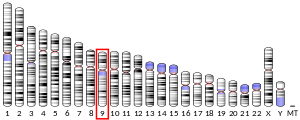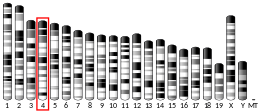RGS3
Regulator of G-protein signaling 3 is a protein that in humans is encoded by the RGS3 gene.[5][6][7]
This gene encodes a member of the regulator of G-protein signaling (RGS) family. This protein is a GTP-ase activating protein which inhibits G-protein mediated signal transduction. The protein is largely cytosolic, but G-protein activation leads to translocation of this protein to the plasma membrane. A nuclear form of this protein has also been described, but its sequence has not been identified. Multiple alternatively spliced transcript variants have been described for this gene but the full-length nature of some transcripts is not yet known.[7]
References
- ^ a b c GRCh38: Ensembl release 89: ENSG00000138835 – Ensembl, May 2017
- ^ a b c GRCm38: Ensembl release 89: ENSMUSG00000059810 – Ensembl, May 2017
- ^ "Human PubMed Reference:". National Center for Biotechnology Information, U.S. National Library of Medicine.
- ^ "Mouse PubMed Reference:". National Center for Biotechnology Information, U.S. National Library of Medicine.
- ^ Druey KM, Blumer KJ, Kang VH, Kehrl JH (May 1996). "Inhibition of G-protein-mediated MAP kinase activation by a new mammalian gene family". Nature. 379 (6567): 742–6. Bibcode:1996Natur.379..742D. doi:10.1038/379742a0. PMID 8602223. S2CID 4362632.
- ^ Linares JL, Wendling C, Tomasetto C, Rio MC (Nov 2000). "C2PA, a new protein expressed during mouse spermatogenesis". FEBS Lett. 480 (2–3): 249–54. doi:10.1016/S0014-5793(00)01942-6. PMID 11034339. S2CID 12703563.
- ^ a b "Entrez Gene: RGS3 regulator of G-protein signalling 3".
Further reading
- Maruyama K, Sugano S (1994). "Oligo-capping: a simple method to replace the cap structure of eukaryotic mRNAs with oligoribonucleotides". Gene. 138 (1–2): 171–4. doi:10.1016/0378-1119(94)90802-8. PMID 8125298.
- Chatterjee TK, Eapen A, Kanis AB, Fisher RA (1998). "Genomic organization, 5'-flanking region, and chromosomal localization of the human RGS3 gene". Genomics. 45 (2): 429–33. doi:10.1006/geno.1997.4929. PMID 9344672.
- Suzuki Y, Yoshitomo-Nakagawa K, Maruyama K, Suyama A, Sugano S (1997). "Construction and characterization of a full length-enriched and a 5'-end-enriched cDNA library". Gene. 200 (1–2): 149–56. doi:10.1016/S0378-1119(97)00411-3. PMID 9373149.
- Dulin NO, Sorokin A, Reed E, Elliott S, Kehrl JH, Dunn MJ (1999). "RGS3 Inhibits G Protein-Mediated Signaling via Translocation to the Membrane and Binding to Gα11". Mol. Cell. Biol. 19 (1): 714–23. doi:10.1128/MCB.19.1.714. PMC 83928. PMID 9858594.
- Dulin NO, Pratt P, Tiruppathi C, Niu J, Voyno-Yasenetskaya T, Dunn MJ (2000). "Regulator of G protein signaling RGS3T is localized to the nucleus and induces apoptosis". J. Biol. Chem. 275 (28): 21317–23. doi:10.1074/jbc.M910079199. PMID 10749886.
- Shi CS, Lee SB, Sinnarajah S, Dessauer CW, Rhee SG, Kehrl JH (2001). "Regulator of G-protein signaling 3 (RGS3) inhibits Gbeta1gamma 2-induced inositol phosphate production, mitogen-activated protein kinase activation, and Akt activation". J. Biol. Chem. 276 (26): 24293–300. doi:10.1074/jbc.M100089200. PMID 11294858.
- Lu Q, Sun EE, Klein RS, Flanagan JG (2001). "Ephrin-B reverse signaling is mediated by a novel PDZ-RGS protein and selectively inhibits G protein-coupled chemoattraction". Cell. 105 (1): 69–79. doi:10.1016/S0092-8674(01)00297-5. PMID 11301003. S2CID 12590781.
- Mittmann C, Schüler C, Chung CH, Not Available NA, Not Available NA, Not Available NA, Not Available NA (2001). "Evidence for a short form of RGS3 preferentially expressed in the human heart". Naunyn-Schmiedeberg's Arch. Pharmacol. 363 (4): 456–63. doi:10.1007/s002100000376. PMID 11330340. S2CID 36657400.
- Niu J, Scheschonka A, Druey KM, Davis A, Reed E, Kolenko V, Bodnar R, Voyno-Yasenetskaya T, Du X (2002). "RGS3 interacts with 14-3-3 via the N-terminal region distinct from the RGS (regulator of G-protein signalling) domain". Biochem. J. 365 (Pt 3): 677–84. doi:10.1042/BJ20020390. PMC 1222729. PMID 11985497.
- Kehrl JH, Srikumar D, Harrison K, Wilson GL, Shi CS (2002). "Additional 5' exons in the RGS3 locus generate multiple mRNA transcripts, one of which accounts for the origin of human PDZ-RGS3". Genomics. 79 (6): 860–8. doi:10.1006/geno.2002.6773. PMID 12036301.
- Ikeda M, Okai M, Miyoshi T, Tone S, Minatogawa Y (2003). "Transcriptional suppression of the estrogen receptor by truncated estrogen receptor-alpha". Horm. Metab. Res. 34 (8): 425–30. doi:10.1055/s-2002-33599. PMID 12198596. S2CID 260167468.
- Hirabayashi S, Ohno H, Iida J, Hata Y (2003). "C2PA is a nuclear protein implicated in the heat shock response". J. Cell. Biochem. 87 (1): 65–74. doi:10.1002/jcb.10279. PMID 12210723. S2CID 45812827.
- Strausberg RL, Feingold EA, Grouse LH, Derge JG, Klausner RD, Collins FS, Wagner L, Shenmen CM, Schuler GD (2003). "Generation and initial analysis of more than 15,000 full-length human and mouse cDNA sequences". Proc. Natl. Acad. Sci. U.S.A. 99 (26): 16899–903. Bibcode:2002PNAS...9916899M. doi:10.1073/pnas.242603899. PMC 139241. PMID 12477932.
- Ota T, Suzuki Y, Nishikawa T, Otsuki T, Sugiyama T, Irie R, Wakamatsu A, Hayashi K, Sato H (2004). "Complete sequencing and characterization of 21,243 full-length human cDNAs". Nat. Genet. 36 (1): 40–5. doi:10.1038/ng1285. PMID 14702039.
- Humphray SJ, Oliver K, Hunt AR, Plumb RW, Loveland JE, Howe KL, Andrews TD, Searle S, Hunt SE (2004). "DNA sequence and analysis of human chromosome 9". Nature. 429 (6990): 369–74. Bibcode:2004Natur.429..369H. doi:10.1038/nature02465. PMC 2734081. PMID 15164053.
- Tovey SC, Willars GB (2005). "Single-cell imaging of intracellular Ca2+ and phospholipase C activity reveals that RGS 2, 3, and 4 differentially regulate signaling via the Galphaq/11-linked muscarinic M3 receptor". Mol. Pharmacol. 66 (6): 1453–64. doi:10.1124/mol.104.005827. PMID 15383626. S2CID 24368533.
- Gerhard DS, Wagner L, Feingold EA, Shenmen CM, Grouse LH, Schuler G, Klein SL, Old S, Rasooly R (2004). "The Status, Quality, and Expansion of the NIH Full-Length cDNA Project: The Mammalian Gene Collection (MGC)". Genome Res. 14 (10B): 2121–7. doi:10.1101/gr.2596504. PMC 528928. PMID 15489334.
- Rual JF, Venkatesan K, Hao T, Hirozane-Kishikawa T, Dricot A, Li N, Berriz GF, Gibbons FD, Dreze M (2005). "Towards a proteome-scale map of the human protein-protein interaction network". Nature. 437 (7062): 1173–8. Bibcode:2005Natur.437.1173R. doi:10.1038/nature04209. PMID 16189514. S2CID 4427026.









